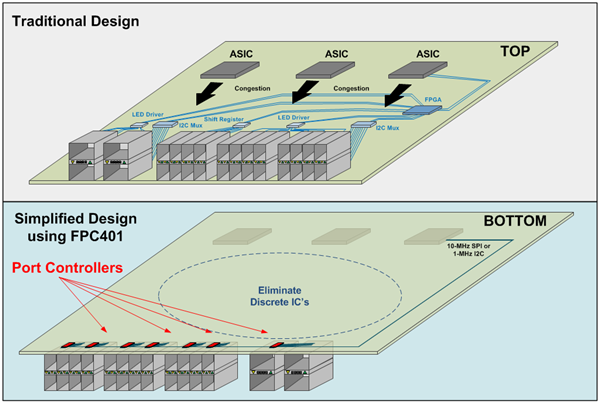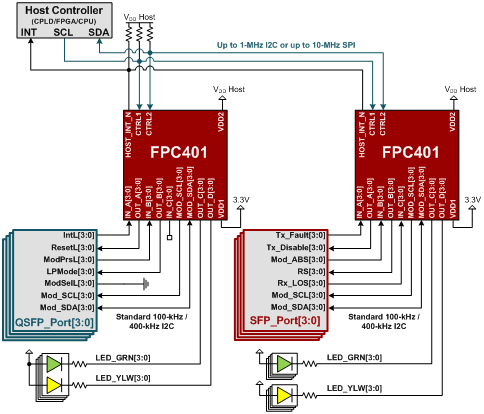SSZTAG5 january 2017 FPC401
Top-of-rack (ToR) switches, routers, servers and storage, types of today’s high-speed communications equipment, are among the most sleek, powerful and meticulously designed workhorses of the data center. They contain impressive circuitry, pushing +25Gbps with scores of ports, complex switch application-specific integrated circuits (ASICs) and sophisticated signal-conditioning devices.
It is very easy to forget that for every high-speed port (small form-factor pluggable (SFP), quad small form-factor pluggable (QSFP), serial attached small computer system interface (SAS) and so on) there are between four and nine low-speed signals associated with that port that need managing. This means that, for a high-port-count system such as a 48-port ToR switch, there may be more than 400 low-speed signals. That’s a lot of wires!
To route and manage all of these signals, typical implementations involve high-pin-count field-programmable gate arrays (FPGAs), I2C multiplexers, shift registers, LED drivers and an extra printed circuit board (PCB) layer. These approaches are difficult to implement, crowd the board and do not scale easily – that is, until now. TI’s FPC401 quad-port controller enables a much simpler solution to this design challenge.
The result is a system with a 100 times reduction in signal routing across the board, a 100 times reduction in FPGA pin count, the elimination of many space-consuming discrete components and an overall simplification of port management – see Figure 1.
 Figure 1 A traditional solution vs. an
FPC401-based solution
Figure 1 A traditional solution vs. an
FPC401-based solutionThe FPC401 aggregates all low-speed signals for up to 56 ports into a single, fast I2C bus (up to 1MHz) or a serial peripheral interface (SPI) bus (up to 10 MHz), greatly reducing routing complexity and simplifying design scalability. The FPC401 has three inputs, four outputs and an I2C master for each of the four ports, enabling full control of the downstream module. Refer to Figure 2 for examples of SFP and QSFP connections.
 Figure 2 FPC401 simplified schematic
for a typical application
Figure 2 FPC401 simplified schematic
for a typical applicationEach input has interrupt-generating capabilities to alert the host to important events, such as an unplugged module. There are multiple general-purpose outputs, as well as two special-purpose outputs that have advanced LED driving capabilities with blinking and brightness control. Each port’s I2C master operates independently, which enables reading and writing across all ports simultaneously. The FPC401 has features to simplify your system software, such as periodic pre-fetch of module data and handling of module I2C protocol mishaps. The best part is that the FPC401 is small enough to fit underneath the SFP or QSFP cage, on the bottom side of the board.
A downloadable C function library makes the integration of the FPC401 into your system a seamless process. The FPC401EVM evaluation board allows you to test the functionality of the FPC401 with your own host controller or an on-board MSP430™ microcontroller.
It may be easy to forget the numerous low-speed signals in high-speed applications, and with the FPC401’s help, you can implement this part of your circuit quickly and turn your focus toward the more important high-speed portions of your design.
Heading to DesignCon? Stop by TI Booth 1234 and see the FPC401 port controller in action!
Additional Resources
- Learn more about the FPC401 port controller.
- Download the FPC401 data sheet.
- Interested in high-speed systems? Check out these posts from the Eye Doctor blog series: